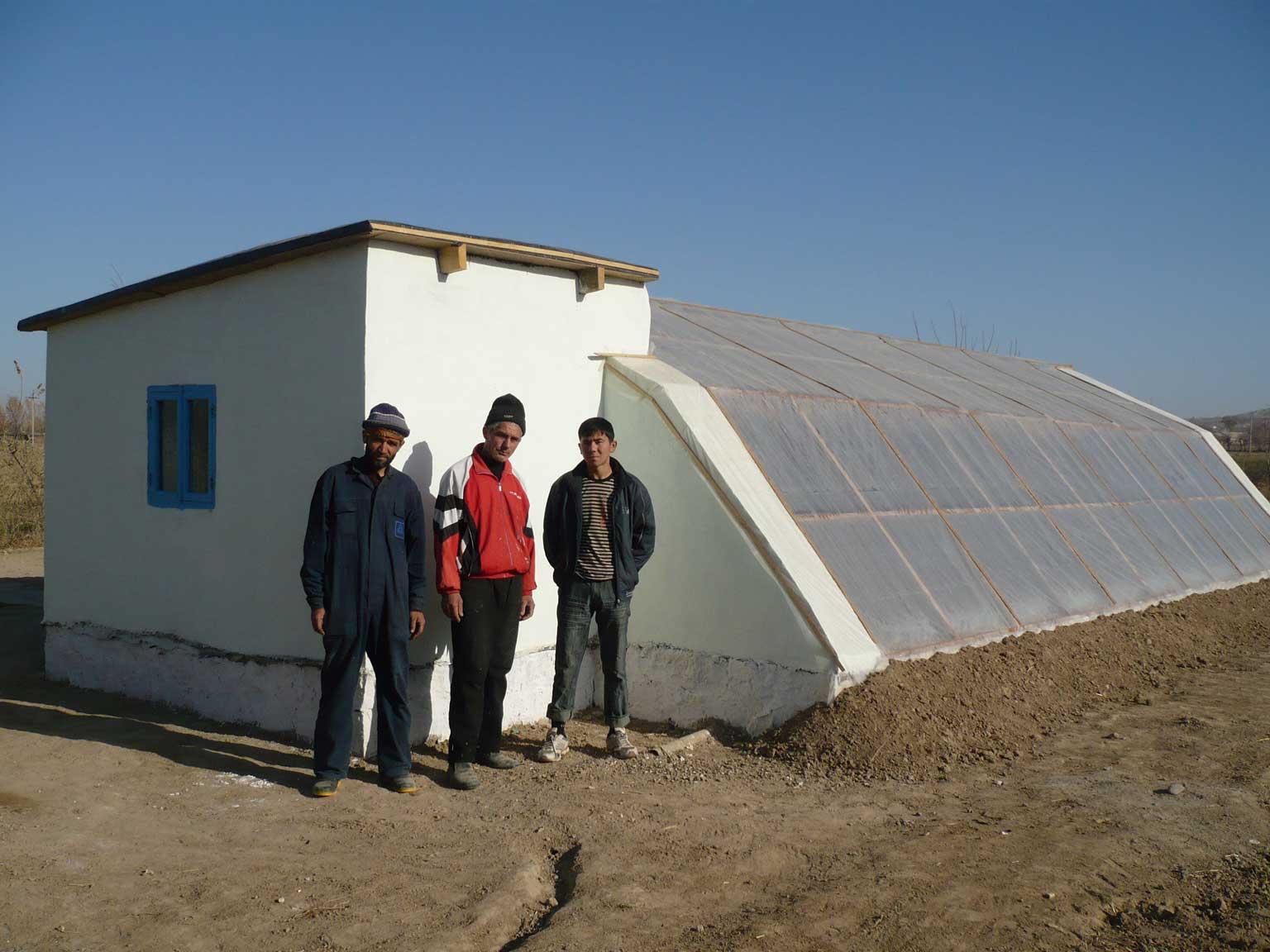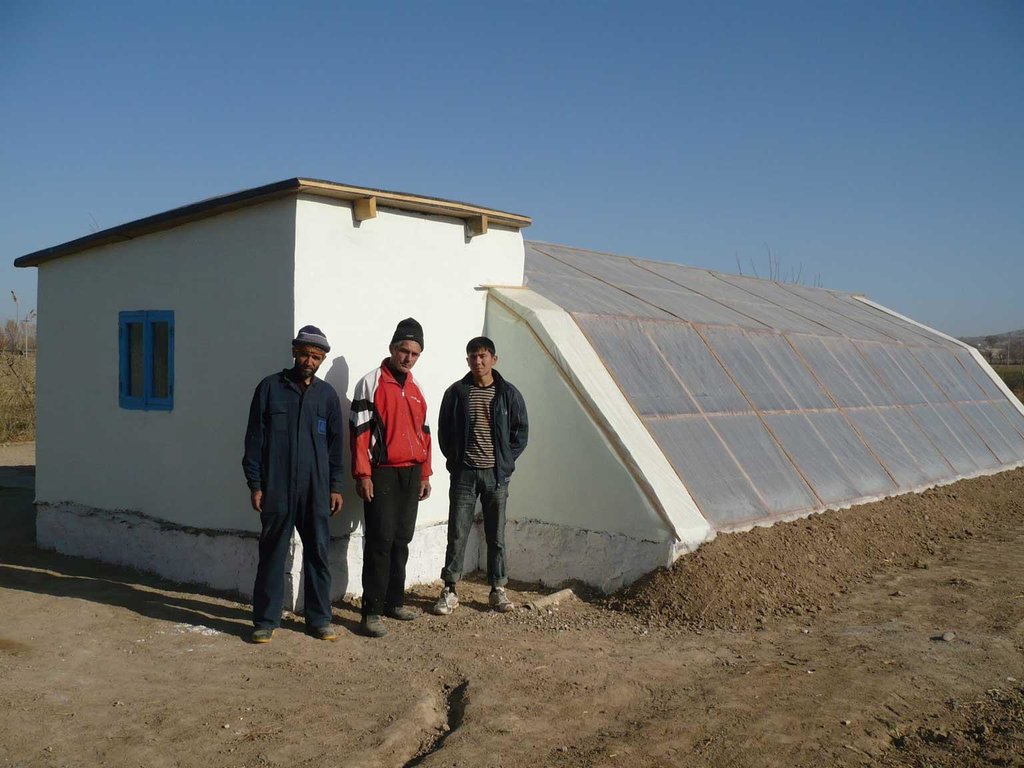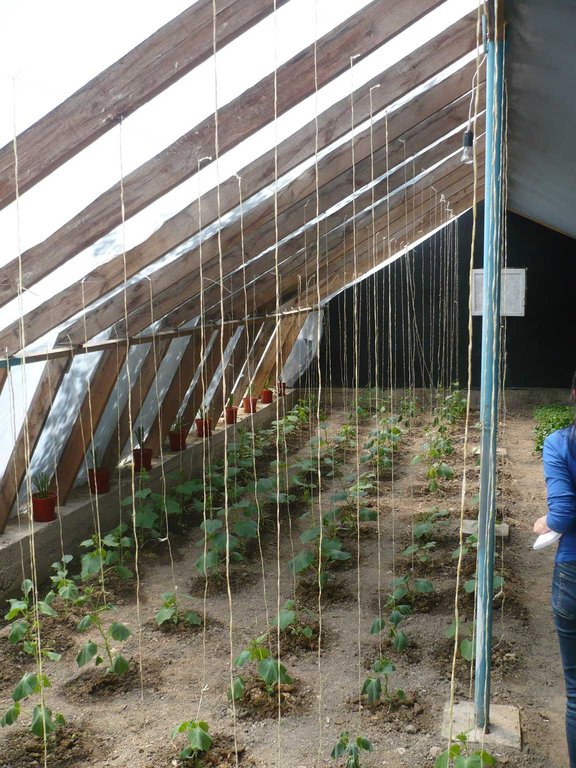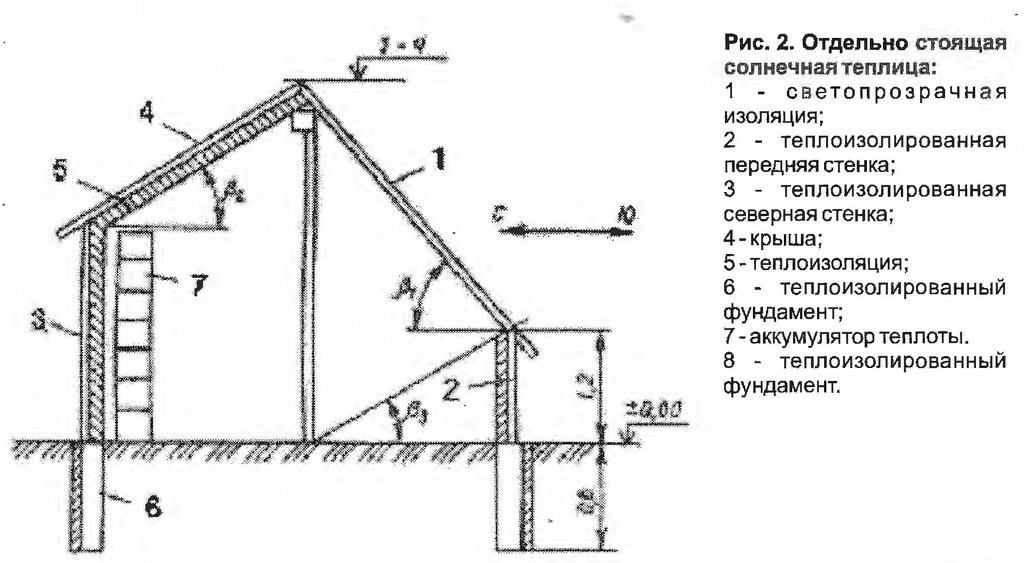Solar greenhouses [Tajikistan]
- Creation:
- Update:
- Compiler: Rustam Kalandarov
- Editor: –
- Reviewers: David Streiff, Alexandra Gavilano
Гармхонаи офтоби (Garmkhonai oftobi)
technologies_1032 - Tajikistan
View sections
Expand all Collapse all1. General information
1.2 Contact details of resource persons and institutions involved in the assessment and documentation of the Technology
Name of the institution(s) which facilitated the documentation/ evaluation of the Technology (if relevant)
Youth Ecological Center, Tajikistan (Youth Ecological Center, Tajikistan) - Tajikistan1.3 Conditions regarding the use of data documented through WOCAT
When were the data compiled (in the field)?
28/04/2011
The compiler and key resource person(s) accept the conditions regarding the use of data documented through WOCAT:
Yes
2. Description of the SLM Technology
2.1 Short description of the Technology
Definition of the Technology:
Growing crops in solar greenhouses to support a year round crop yield.
2.2 Detailed description of the Technology
Description:
Solar greenhouses can be used all year round irrespective of weather conditions, especially in the winter period, when farmers are able to grow vegetables by using natural heat energy. The greenhouses provide a good growing environment as they are insulated and make use of passive solar energy.
This solar greenhouse has three walls which reflect the sun's rays and accumulate heat. The front wall is heat-insulated. Two walls are black and one is white.
Purpose of the Technology: Protect plants from spring and autumn cold spells, including frosts. Extending the natural growing season.
Establishment / maintenance activities and inputs: Selection of the structure of greenhouse, selection of crops, effective ventilation and watering, use of agrotechnology, pest and disease control. Soil control: regeneration, disinfection, mulching, biohumus and drip irrigation in greenhouses.
Natural / human environment: This type of greenhouse can be used for many years in extreme climate conditions, saline soils, unpredictable weather (frosts) and with lack of water resources.
2.3 Photos of the Technology
2.5 Country/ region/ locations where the Technology has been applied and which are covered by this assessment
Country:
Tajikistan
Region/ State/ Province:
Tajikistan
Further specification of location:
Khatlon District, Nosiri Husrav region
Map
×2.6 Date of implementation
If precise year is not known, indicate approximate date:
- less than 10 years ago (recently)
2.7 Introduction of the Technology
Specify how the Technology was introduced:
- through land users' innovation
- through projects/ external interventions
Comments (type of project, etc.):
The first experimental greenhouse was established in 2005 with the use of sketches downloaded from the Internet. Farmers have adapted the technology and introduced a series of innovations to this tehnology, including spray irrigation and a more effective design.
3. Classification of the SLM Technology
3.1 Main purpose(s) of the Technology
- improve production
3.2 Current land use type(s) where the Technology is applied

Cropland
- Annual cropping

Settlements, infrastructure
Comments:
Major land use problems (compiler’s opinion): Soil salinity, lack of water, climate change
Major land use problems (land users’ perception): Intensive land use type and getting early yield
Future (final) land use (after implementation of SLM Technology): Cropland: Ca: Annual cropping
Constraints of settlement / urban
If land use has changed due to the implementation of the Technology, indicate land use before implementation of the Technology:
Cropland: Ca: Annual cropping
3.3 Further information about land use
Water supply for the land on which the Technology is applied:
- mixed rainfed-irrigated
Comments:
Water supply also, full irrigation
Number of growing seasons per year:
- 2
Specify:
Longest growing period in days: 150Longest growing period from month to month: December - AprilSecond longest growing period in days: 180Second longest growing period from month to month: March - August
3.4 SLM group to which the Technology belongs
- greenhouses
3.5 Spread of the Technology
Specify the spread of the Technology:
- evenly spread over an area
If the Technology is evenly spread over an area, indicate approximate area covered:
- < 0.1 km2 (10 ha)
3.6 SLM measures comprising the Technology

agronomic measures
- A1: Vegetation/ soil cover

vegetative measures
- V5: Others

structural measures
- S6: Walls, barriers, palisades, fences

management measures
- M2: Change of management/ intensity level
Comments:
Main measures: structural measures
Secondary measures: agronomic measures, vegetative measures, management measures
Type of agronomic measures: early planting, relay cropping, mulching, manure / compost / residues, rotations / fallows, breaking compacted topsoil, non-inversion tillage
3.7 Main types of land degradation addressed by the Technology

soil erosion by wind
- Et: loss of topsoil

physical soil deterioration
- Pu: loss of bio-productive function due to other activities

biological degradation
- Bq: quantity/ biomass decline
Comments:
Main type of degradation addressed: Pu: loss of bio-productive function due to other activities
Secondary types of degradation addressed: Et: loss of topsoil, Bq: quantity / biomass decline
Main causes of degradation: change in temperature (Adaptation to climate change), droughts (Water saving in case of droughts), poverty / wealth (Income from greenhouse), labour availability
Secondary causes of degradation: soil management
3.8 Prevention, reduction, or restoration of land degradation
Specify the goal of the Technology with regard to land degradation:
- restore/ rehabilitate severely degraded land
Comments:
Secondary goals: prevention of land degradation, mitigation / reduction of land degradation
4. Technical specifications, implementation activities, inputs, and costs
4.1 Technical drawing of the Technology
4.2 Technical specifications/ explanations of technical drawing
The drawing shows the scheme of the greenhouse. This greenhouse differs from other greenhouses as it has three specific walls. Each wall is directed towards the sun. The major heat-saving wall is black. Other walls are of white to reflect rays. The roof is covered with polyethylene film.
Location: South of Tajikistan. Nosiri Husrav region
Date: 2011.05.05
Technical knowledge required for field staff / advisors: moderate
Technical knowledge required for land users: moderate (Basic knowledge of agrotechnology is needed)
Main technical functions: Artificial soil conservation
Secondary technical functions: control of raindrop splash, improvement of ground cover, increase in organic matter, increase in nutrient availability (supply, recycling,…), water harvesting / increase water supply, increase of biomass (quantity)
Early planting
Remarks: almost all the year round
Relay cropping
Remarks: 3-4 times a year
Rotations / fallows
Remarks: once every 3 years
Aligned: -contour
Vegetative material: O : other
Vertical interval between rows / strips / blocks (m): 0.3
Spacing between rows / strips / blocks (m): 0.7
Change of land use type
4.3 General information regarding the calculation of inputs and costs
Specify currency used for cost calculations:
- US Dollars
4.4 Establishment activities
| Activity | Type of measure | Timing | |
|---|---|---|---|
| 1. | disease control | Vegetative | |
| 2. | growing seedlings in flowerpots | Vegetative | |
| 3. | planting seedlings | Vegetative | |
| 4. | watering, agro-maintenance | Vegetative | |
| 5. | disease control | Vegetative | |
| 6. | vertical tying | Vegetative | |
| 7. | Training for farmers | Management | periodically |
| 8. | борьба с заболеваниями | ||
| 9. | вертикальная подвязка | ||
| 10. | обучение фермеров | периодически |
4.5 Costs and inputs needed for establishment
| Specify input | Unit | Quantity | Costs per Unit | Total costs per input | % of costs borne by land users | |
|---|---|---|---|---|---|---|
| Labour | Growing of seedlings | Persons/day | 100.0 | 5.0 | 500.0 | 50.0 |
| Labour | Diseas control | Greenhouses | 10.0 | 20.0 | 200.0 | 50.0 |
| Labour | Training for farmers | Trainings | 1.0 | 100.0 | 100.0 | 50.0 |
| Labour | Planting/Watering/Building Greenhouse | Greenhouses | 10.0 | 130.0 | 1300.0 | |
| Plant material | Seeds | Greenhouses | 10.0 | 50.0 | 500.0 | 50.0 |
| Plant material | Compost manure | Greenhouses | 10.0 | 20.0 | 200.0 | 50.0 |
| Plant material | Pesticides | Greenhouses | 10.0 | 20.0 | 200.0 | 50.0 |
| Construction material | Material | Greenhouse | 10.0 | 100.0 | 1000.0 | 50.0 |
| Total costs for establishment of the Technology | 4000.0 | |||||
4.6 Maintenance/ recurrent activities
| Activity | Type of measure | Timing/ frequency | |
|---|---|---|---|
| 1. | Ventilation, watering, temperature regime | Agronomic | constantly |
| 2. | Change of soil, improvement of soil fertility | Agronomic | every 3 years |
| 3. | Disease control | Agronomic | seasonal |
4.7 Costs and inputs needed for maintenance/ recurrent activities (per year)
| Specify input | Unit | Quantity | Costs per Unit | Total costs per input | % of costs borne by land users | |
|---|---|---|---|---|---|---|
| Labour | Vetilation/Watering/change of Soil/disease control | Greenhouses | 10.0 | 200.0 | 2000.0 | 50.0 |
| Total costs for maintenance of the Technology | 2000.0 | |||||
Comments:
Machinery/ tools: water collecting equipment, sprayers
4.8 Most important factors affecting the costs
Describe the most determinate factors affecting the costs:
Labour - voluntary contribution
5. Natural and human environment
5.1 Climate
Annual rainfall
- < 250 mm
- 251-500 mm
- 501-750 mm
- 751-1,000 mm
- 1,001-1,500 mm
- 1,501-2,000 mm
- 2,001-3,000 mm
- 3,001-4,000 mm
- > 4,000 mm
Agro-climatic zone
- arid
Thermal climate class: subtropics
5.2 Topography
Slopes on average:
- flat (0-2%)
- gentle (3-5%)
- moderate (6-10%)
- rolling (11-15%)
- hilly (16-30%)
- steep (31-60%)
- very steep (>60%)
Landforms:
- plateau/plains
- ridges
- mountain slopes
- hill slopes
- footslopes
- valley floors
Altitudinal zone:
- 0-100 m a.s.l.
- 101-500 m a.s.l.
- 501-1,000 m a.s.l.
- 1,001-1,500 m a.s.l.
- 1,501-2,000 m a.s.l.
- 2,001-2,500 m a.s.l.
- 2,501-3,000 m a.s.l.
- 3,001-4,000 m a.s.l.
- > 4,000 m a.s.l.
5.3 Soils
Soil depth on average:
- very shallow (0-20 cm)
- shallow (21-50 cm)
- moderately deep (51-80 cm)
- deep (81-120 cm)
- very deep (> 120 cm)
Soil texture (topsoil):
- medium (loamy, silty)
Topsoil organic matter:
- low (<1%)
If available, attach full soil description or specify the available information, e.g. soil type, soil PH/ acidity, Cation Exchange Capacity, nitrogen, salinity etc.
Soil fertility is low-medium
Soil drainage / infiltration is good
Soil water storage capacity is low
5.4 Water availability and quality
Ground water table:
5-50 m
Availability of surface water:
medium
Water quality (untreated):
poor drinking water (treatment required)
5.5 Biodiversity
Species diversity:
- medium
5.6 Characteristics of land users applying the Technology
Market orientation of production system:
- mixed (subsistence/ commercial
Off-farm income:
- 10-50% of all income
Relative level of wealth:
- poor
- average
Individuals or groups:
- individual/ household
Level of mechanization:
- manual work
Gender:
- women
Indicate other relevant characteristics of the land users:
Land users applying the Technology are mainly common / average land users
Population density: 50-100 persons/km2
Annual population growth: 2% - 3%
5.7 Average area of land owned or leased by land users applying the Technology
- < 0.5 ha
- 0.5-1 ha
- 1-2 ha
- 2-5 ha
- 5-15 ha
- 15-50 ha
- 50-100 ha
- 100-500 ha
- 500-1,000 ha
- 1,000-10,000 ha
- > 10,000 ha
Is this considered small-, medium- or large-scale (referring to local context)?
- small-scale
5.8 Land ownership, land use rights, and water use rights
Land ownership:
- communal/ village
- individual, not titled
Land use rights:
- communal (organized)
- leased
5.9 Access to services and infrastructure
health:
- poor
- moderate
- good
education:
- poor
- moderate
- good
technical assistance:
- poor
- moderate
- good
employment (e.g. off-farm):
- poor
- moderate
- good
markets:
- poor
- moderate
- good
energy:
- poor
- moderate
- good
roads and transport:
- poor
- moderate
- good
drinking water and sanitation:
- poor
- moderate
- good
financial services:
- poor
- moderate
- good
6. Impacts and concluding statements
6.1 On-site impacts the Technology has shown
Socio-economic impacts
Production
crop production
risk of production failure
product diversity
Income and costs
farm income
diversity of income sources
Socio-cultural impacts
food security/ self-sufficiency
situation of socially and economically disadvantaged groups
Livelihood and human well-being
Ecological impacts
Water cycle/ runoff
harvesting/ collection of water
evaporation
Soil
soil cover
nutrient cycling/ recharge
soil organic matter/ below ground C
6.3 Exposure and sensitivity of the Technology to gradual climate change and climate-related extremes/ disasters (as perceived by land users)
Gradual climate change
Gradual climate change
| Season | Type of climatic change/ extreme | How does the Technology cope with it? | |
|---|---|---|---|
| annual temperature | increase | not well |
Climate-related extremes (disasters)
Meteorological disasters
| How does the Technology cope with it? | |
|---|---|
| local rainstorm | not known |
| local windstorm | not known |
Climatological disasters
| How does the Technology cope with it? | |
|---|---|
| drought | well |
Hydrological disasters
| How does the Technology cope with it? | |
|---|---|
| general (river) flood | not well |
Other climate-related consequences
Other climate-related consequences
| How does the Technology cope with it? | |
|---|---|
| reduced growing period | well |
| Temperature decrease | well |
6.4 Cost-benefit analysis
How do the benefits compare with the establishment costs (from land users’ perspective)?
Short-term returns:
positive
Long-term returns:
very positive
How do the benefits compare with the maintenance/ recurrent costs (from land users' perspective)?
Short-term returns:
slightly positive
Long-term returns:
positive
6.5 Adoption of the Technology
- more than 50%
If available, quantify (no. of households and/ or area covered):
15 households in an area of <10 ha
Of all those who have adopted the Technology, how many have did so spontaneously, i.e. without receiving any material incentives/ payments?
- 0-10%
Comments:
100% семей землепользователей применяют эту технологию без дополнительной материальной поддержки
15 семей землепользователей применяют эту технологию без дополнительной материальной поддержки
6.7 Strengths/ advantages/ opportunities of the Technology
| Strengths/ advantages/ opportunities in the compiler’s or other key resource person’s view |
|---|
|
Short-term positive effect, able to grow vegetables in winter in harsh weather conditions How can they be sustained / enhanced? Have a lif span of for 5-10 years |
| Protection from climate change |
|
Long-term technology for adaptation to climate change How can they be sustained / enhanced? Can be used for production of vegetables despite lack of water resources, and changes in outside temperature |
6.8 Weaknesses/ disadvantages/ risks of the Technology and ways of overcoming them
| Weaknesses/ disadvantages/ risks in the compiler’s or other key resource person’s view | How can they be overcome? |
|---|---|
| Cost intensive construction and materials | Compromise between cost and effectiveness |
| Greenhouses are used for growing vegetables | Another technology is being developed |
7. References and links
7.2 References to available publications
Title, author, year, ISBN:
www.ecocentre.tj
Links and modules
Expand all Collapse allLinks
No links
Modules
No modules






